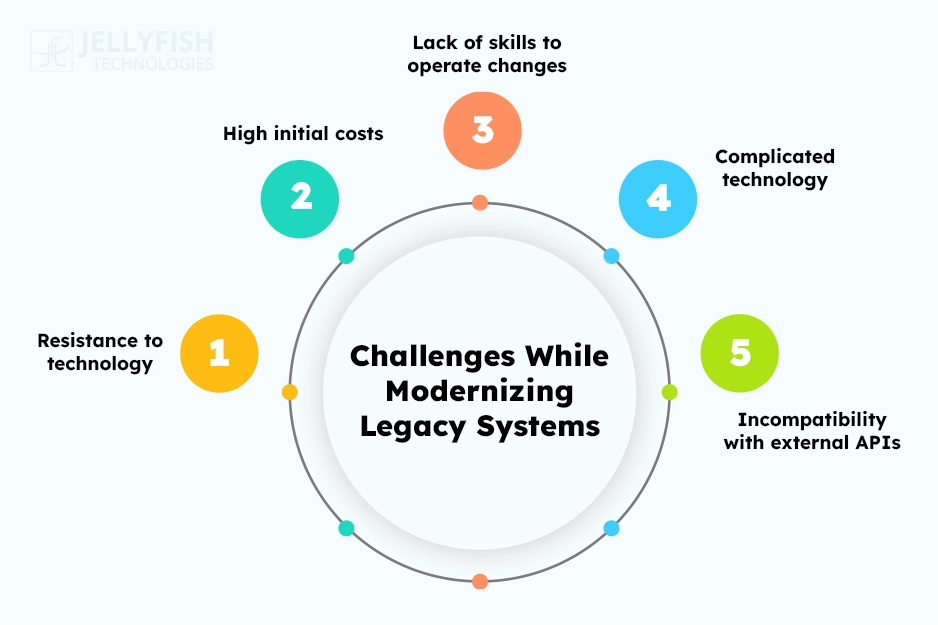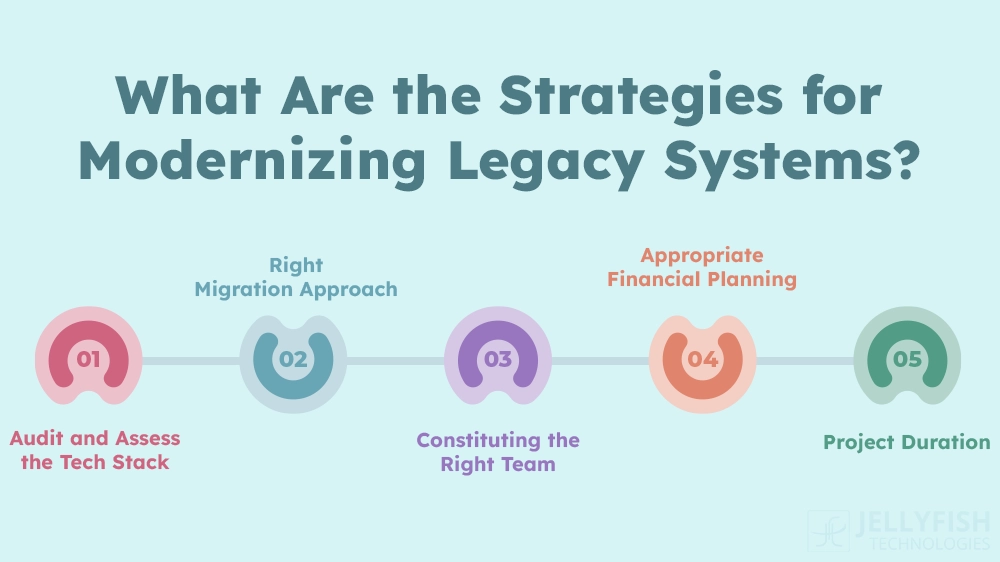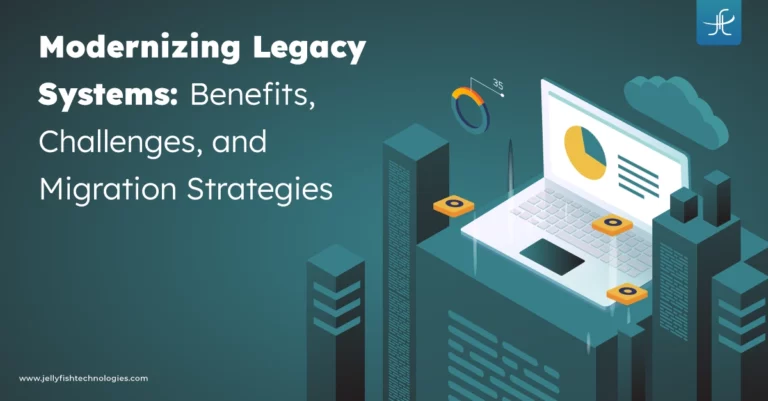It is essentially achieved by matching pace with emerging technologies that support fast development and operational excellence. But at times, businesses self-restrict their growth with the continuous use of legacy software that breaks the opportunities to deliver the best.
If you are new to the term “legacy software,” let’s first understand what they are to learn how they affect a business’s existence.
What Are Legacy Systems?
Legacy systems are relatively obsolete software. Although legacy systems are capable of working and numerous businesses still use them, they produce frequent complications, such as incompatibility with browsers, infrastructure, and current operating systems (OSes).
Legacy software or hardware systems limit the speed of business operations because, unlike upgraded and advanced systems, they deliver limited potential and features. For instance, an application designed to run on Windows 7 will face difficulties running on Windows 10.
Thus, to unlock the competitive advantage, organizations must promote legacy system modernization after an exclusive analysis of their goals. However, there are countless inconveniences businesses anticipate while modernizing legacy systems, such as huge investments, fear of newer technology, difficulty in data migration, or internal resistance to the latest technology or system.
What Are the Benefits of Modernizing Legacy Systems?
Since the era of technological advancements, businesses have experienced a tethered performance due to the non-integration of the latest capabilities and cutting-edge technologies, such as cloud computing, and enhanced data integration.
Listed below are the benefits of modernizing legacy systems.
Operational Cost Reduction
Legacy applications are based on obsolete technologies, increasing the cost to operate them. Many businesses have affirmed that a major portion of their budget is utilized in maintaining legacy systems. Modernizing these systems can automate business processes and significantly reduce operational and maintenance costs.
These downsized costs help in increasing businesses’ ROI and give more opportunities to focus on core competencies.
Business Agility
Monolithic environments are difficult for developers to introduce change into, such as updating codes, servers, and configurations. Conversely, modernized applications encourage more automation, manage business across various platforms, implement faster source code change, migrate databases seamlessly, and manage documentation.
For instance, DevOps integration streamlines operations, reduces costs with synchronized CI/CD pipelines and integrates emerging technology throughout all the phases of a development cycle seamlessly.
Scalability
Scalability is the buzzword to signify the ability of technology to increase its size to handle more data, more users, and more demand without compromising performance, reliability, or security. It essentially helps in driving more revenue, promoting technological growth, and outperforming competitors.
Today, big data analysis, the Internet of Things (IoT), and cloud computing are generating enormous amounts of data resulting in the collapse of an enterprise’s legacy and outdated systems. Scalable apps thus, expunge the susceptibility of interrupted and unreliable services.
Latest Market Trends
System modernization facilitates the integration of recent and robust technology, such as artificial intelligence, machine learning, big data, and cloud computing. These eminent technologies expedite customer service, personalize client handling, and automate query resolution.
Predictive analytics, an outcome of intelligent and modern technologies, is a key feature that bolsters a business by recognizing the latest market trends that resonate with customers and their demands.
Better Security
Modernization promises better security for critical transactions. With modernizing legacy systems, an enterprise gets state-of-the-art DDoS protection, security upgrades, and Application Delivery Controllers (ADCs) that prevent advanced cyber threats.
Consolidated security with legacy applications is a major concern. Generally, cybercriminals target outdated applications and obsolete operating systems to gain access without resistance. According to insights from Cybercrime Magazine, global ransomware costs are predicted to go beyond $265 billion by 2031.
Challenges While Modernizing Legacy Systems
Easier said than done, modernizing legacy systems is a tumultuous task including in-depth analysis and clarity on what is ideal and right for an organization. Some common challenges during technology transitions are listed below.

What Are the Strategies for Modernizing Legacy Systems?
There are several strategies to modernize legacy systems. Some of them are listed below.
Audit and Assess the Tech Stack
Assessing the tech stack, such as UI/UX, code, and architecture gives insights about the infrastructure that adds no value, streamlining operations and costs.

Right Migration Approach
Technology upgrades and migrations can be accomplished through two approaches. The first approach is the big bang that lifts and shifts the technology and upgrades it all at once. The second approach is a phased technique that lowers the risk of failed migration and removes operational hindrances.
Constituting the Right Team
A successful agile team consists of project managers, DevOps engineers, scrum masters, quality analyst leads, developers, and UX designers. Members skilled in their niche ensure that the transformation is comprehensive and collaborative.
Appropriate Financial Planning
Budgeting unlocks the benefits of modernization without exceeding financial limits or increasing operational or shifting costs. High expenditure at times restricts modernization of the current obsolete system. For instance, cloud-based modernization may demand high expenses to unravel the benefits of cloud storage, leading businesses to overlook the requirement.

Project Duration
Modernization of the entire organizational workflow can be time-consuming. Managing sustained work delivery and operational excellence until the entire system is modernized can be challenging. For big-sized enterprises, shifting the gigantic tech stack can take a significant amount of time, stalling the operations and affecting the client base.
Conclusion
Legacy systems are severe hindrances to unleashing the full potential of a business’s resources. Despite harboring skilled workers, legacy systems are something that limits competitiveness, leading to lessened performance and customer dissatisfaction. Therefore, it is needless to say that modernizing legacy systems is a chief requirement for every business.
Jellyfish Technologies is a reliable technology partner that promises advanced IT solutions, such as modernizing legacy systems and replacing them with a better-serving tech stack. Our technical advanced steps facilitate a business to achieve their long-term visions effortlessly and within less time frame.


